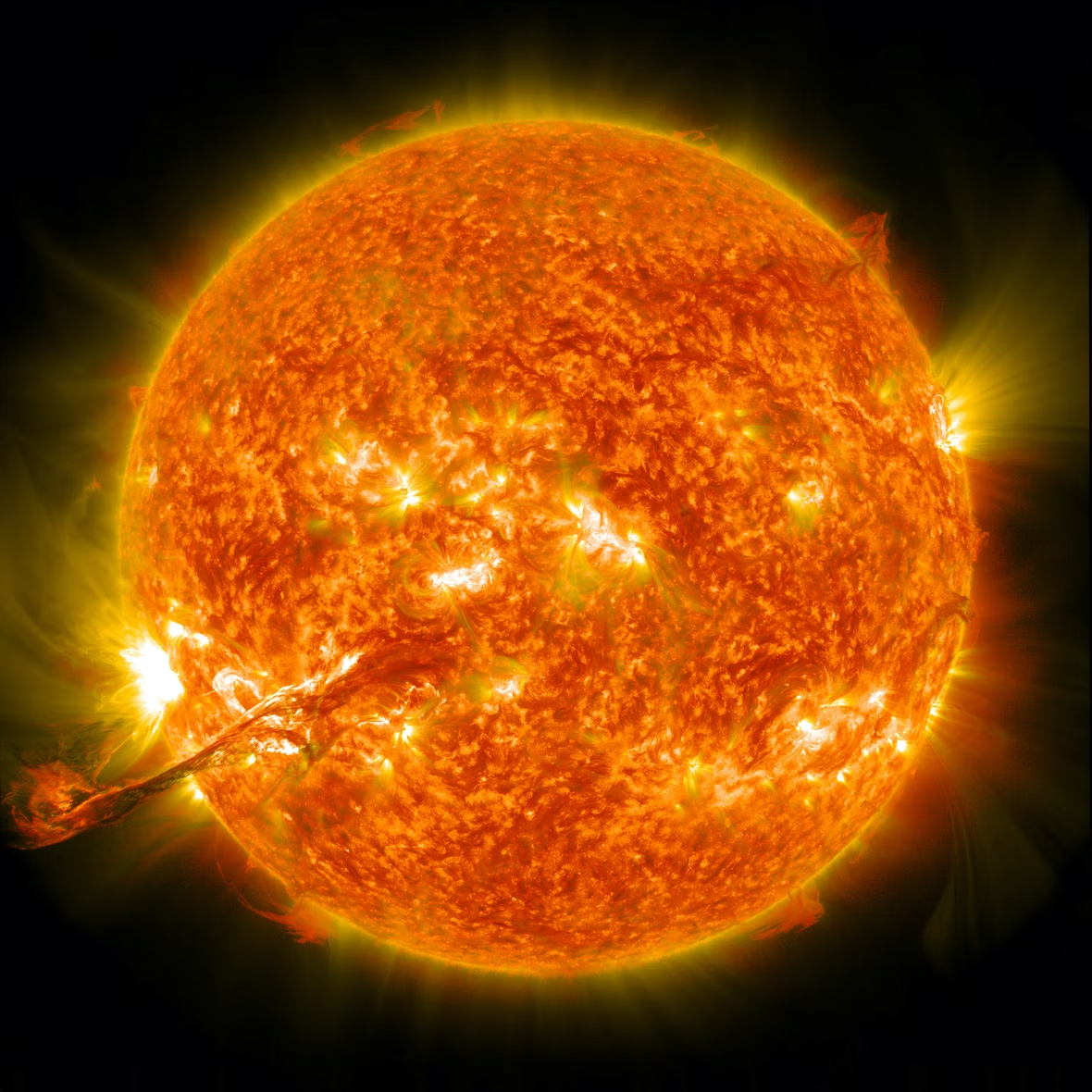
We all look at the sky and wonder sometimes how far away from us the Sun is and what it takes to reach it. Some might even be wondering what it takes to reach the Sun.
If you know that the sun doesn’t have a solid surface, well, at least you’re not wondering what it’s like to land on it. But we can answer the question of how far is the Sun from the earth.
Ready? Let’s get started…
How Far Is The Sun From Earth: Short Summary
The Sun, that’s the largest object we know in our solar system, is about 92 million miles from the Earth. But it takes only 8 minutes and 20 seconds for light to reach our planet. The planet Earth orbits around the Sun in an elliptical pattern. So, the distance between the Earth and the sun is not the same at all times.
And we’ll tell you all about it. We know that one revolution takes us 365 days. Keep reading for more.
Watch: How Far Is Earth from the Sun
How It Changes

The Earth is the closest to planet Earth at the beginning of January. This point is referred to as perihelion and the Earth is about 91.3 million miles away from the Sun at this point. That’s according to NASA, so we can safely rely on it.
But since the orbit is elliptical and the distance between these two objects varies, we’re going to look into it a little deeper. Now, many people think that it’s our distance from the sun that determines our seasons. But it’s actually because of the tilt.
The Earth doesn’t stay steady on its axis when it is revolving around the Sun. the axis is slightly tilted and that’s what causes us to experience a change of seasons. That should explain why the seasons are completely opposite in the southern and northern hemispheres.
The Earth moves to the point where it is farther from the Sun, about half a year from the time it was at the perihelion point. We usually get to this point around early July and when the distance is the greatest is called the aphelion point and here, we are about 94.5 million miles away from the Sun.
Take an average of both points and it’s 93 million miles which is usually what experts are comfortable noting as the distance between the Earth and the sun. But that’s not where the story ends.
The IAU or the International Astronomical Union is a non-profit organization that has been working on, among other things, how to define astronomical constants. In 2012, the members of this international organization took a vote and approved the AU which is an Astronomical Unit.
They use this unit for measurement because it is more precise. According to the IAU, it is defined as the “conventional unit length” that is 149,597,870,700 meters or about 92,955,807 miles.
They decided to standardize this unit of measurement because the value of 1 AU was calculated based on the mass of the sun. And it turns out, that number keeps changing since the Sun constantly converts mass into energy.
Now, if you look at Einstein’s theory of relativity, there’s another little but rather an inconvenient variation. The theory states that space-time is not a constant but relative and is based on where the observer is in a given solar system.
This makes things difficult for scientists when they work on other models related to other planetary objects, doesn’t it? So, they used the speed of light in space, which is a vacuum, to calculate the AU and standardized it in 2012.
Earth to Sun: How Long Does It Take?

This depends on a lot of factors, including the purpose of a given spacecraft, not to mention its own specs. But if you undertake this imaginary journey, it would have to go about 153,454 miles per hour without a break from the sun. In that case, it can be expected to reach the sun in about 25 days or 606 hours.
But in this calculation, we are supposing that it’s the top speed of that aircraft and that it maintains that pace throughout the journey. In reality, that’s now how it works because a spacecraft takes anywhere from a few minutes to hours to reach its full potential in terms of speed.
The fastest of such spacecraft to exist is called the Parker Solar Probe. It is estimated to have reached a maximum of 430,000 miles per hour. So, at this speed, it can reach the sun in about 9 days or 216 hours.
Sounds exciting, but there’s more trouble in the math. Things are not still in space and that includes the sun. It is also revolving, like we do, around the center of our galaxy, the Milky Way.
This means we can’t really launch a spacecraft or any kind of probe at the Sun because we need to know where it will be by the time the spacecraft reaches it.
For that, we need to calculate the speed of the Sun and the speed of the Earth till the spacecraft leaves our atmosphere and is influenced by our gravity. And then, we need to calculate where the sun will be by the time the spacecraft reaches it.
After that, we throw the rate at which the spacecraft is moving into the mix. So, there’s a lot of work to do. Now, it takes light a lot less time than anything else because things without mass can travel with super speed.
The speed of light is an incredible 186,282 miles in just one second. Since the Earth is about 92.96 miles away from the Sun, light takes a little less than eight and a half minutes to reach us, but anything we send takes days to get there, theoretically speaking, of course.
When the Earth is at its closest point to the Sun, light reaches Earth in just 8 minutes and 8 seconds. And when the Earth is at its farthest point from the sun, it takes 8 minutes and 27 seconds to get here. So, if there was no Sun tomorrow, we’d take a little over eight minutes to know that.
Well, that’s not true because the entire Earth doesn’t experience night at the same time. Plus, all the monitoring we do from out there will let us know.
Are We Getting Closer? Is The Distance Melting?

Some people wonder if the Earth is getting closer to the sun over time and if it means that we would be able to get to the surface of the Sun sooner. For one, that’s not true because the Sun doesn’t actually have a surface for us to land on.
It’s an exploding collection of gases and we’re not getting close to it. Now, even if we were getting closer to the sun, that’s actually not helpful in any way. It’s also helpful to remember here that in the future, we might just develop other ways of collecting data from the sun without approaching it.
As far as the distance between the Earth and the sun are concerned, we are not getting closer. In fact, experts have determined that our planet is moving further away from the Sun. Why is that happening?
The sun has a gravitational pull that determines the movement of our planet. This gravitational pull comes from the burning of its fuel. And at this point in time, it is burning a lot of fuel which has led to a loss of gravity, mass and power. All this loss of mass and gravity is causing the Earth to move away.
This change is happening 15 centimeters at a time annually. But don’t worry. We won’t escape completely away from the sun for at least another 5 billion years when the sun will turn into a giant red star. And according to current estimates, the Earth will perish far, far before that.
And even if we’re wrong about that and somehow manage to make it to the end of the lifespan of the sun as we know it, theories say that the sun will expand immensely before it turns into a red giant star. And it will engulf everything in its path, including the Earth, in that process.
How Long Are Days on the Sun?
This is just a fun little detail and the answer depends on where you are calculating it on the sun. Since the sun is all gas and some plasma, it has layers that move at different speeds.
We determine the speed of these layers depending on things like sunspots that are visible to us. The simple answer regarding the length of a day on sun, called a solar day, is about 27 days for us on Earth.
But if you were calculating it from the equator on the sun, a solar day is about 25 Earth days long.
Frequently Asked Questions

Q: How Close Could a Human Get to the Sun?
A: While the sun is about 93 miles from us, you can be about 95 yards away before you burn.
Q: How Long Will It Take to Travel to the Sun?
A: This depends on various factors, as mentioned before, but actually, there’s a mathematical formula to calculate it. If the sun is about 149 million km away, it will take 222 days or 5,321 hours to reach it.
The formula is time = distance/speed
Conclusion & Summary
Now you know that the distance between the sun and the Earth keeps changing because these two celestial bodies have their own internal (and external) logic. But roughly speaking, the sun is about 93 million miles away.
